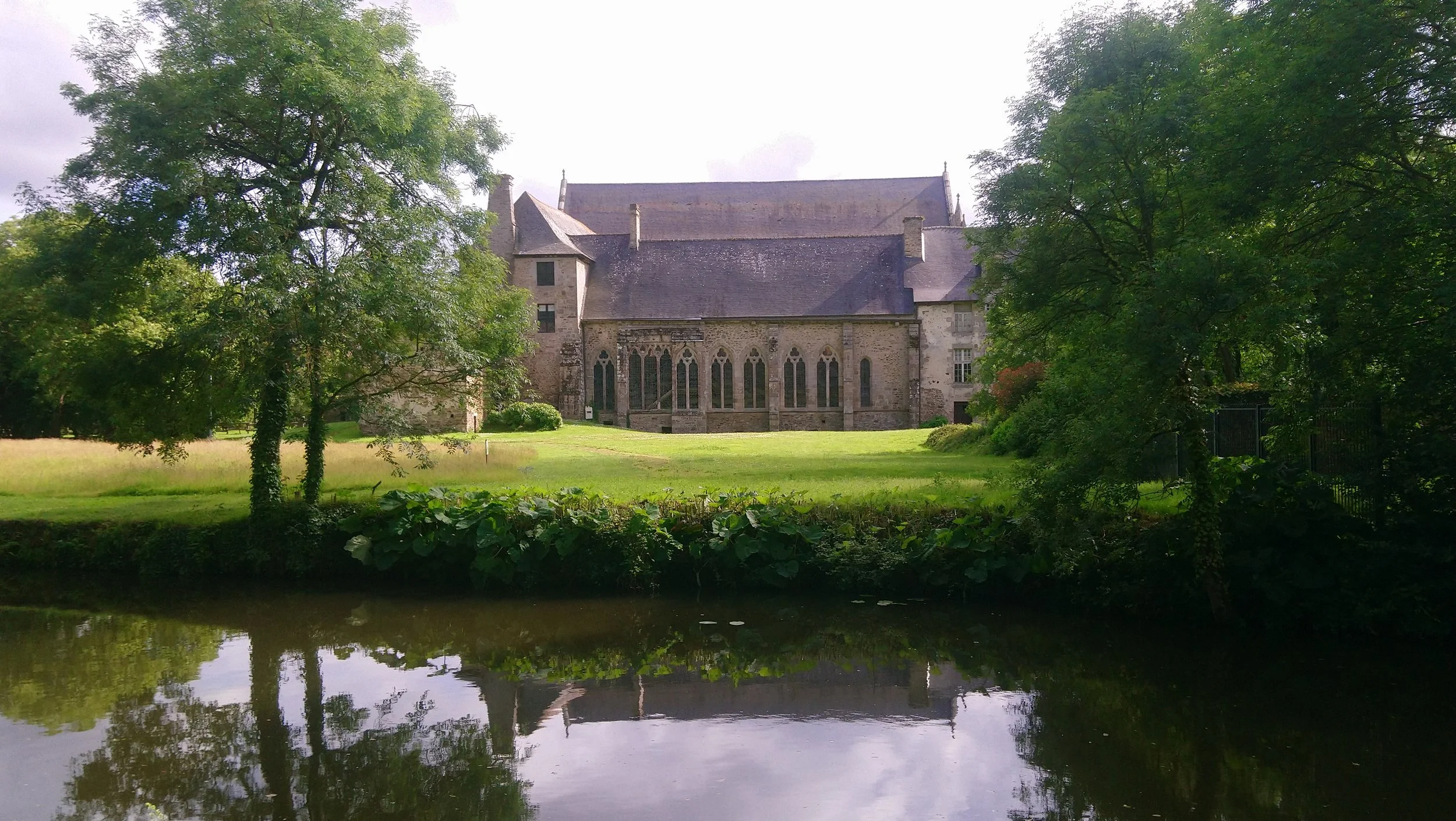…At a bend in the Rance River I see ancient stone buildings rising among the trees on the opposite bank. I reach them across another lovely stone bridge... arriving into a supernaturally pretty street, cobbled and lined with chests of pink geraniums and backed by venerable houses, their faded ruddy stone picked out by bright blue and red shutters.
The entrance to the priory appears on my right. In the courtyard a couple is sitting on a stone bench, relaxing in the evening sun, she in pink and he in blue. They must be seventy-five, and somehow they look, well… complete. Instantly my mind strides a stone corridor of religious conviction… Presumably they have been visiting the abbey. Perhaps their faith gives them such a bond.
Turns out the abbey is locked, so I’ll need to return tomorrow morning on my way out of town. But I have a piece of luck: I can visit the castle. That stays open until seven. Actually the couple aren’t sunning themselves; they’re fussing, organising and reorganising kit.
I point myself in the direction of the castle – which stands above me on a mound of out of control greenery. There’s a naughty boy’s short-cut, a break in the fence, that gives onto a path snaking up through the trees. Eventually a modernist balustrade and boardwalk leads me to the west tower and entrance.
Eeeek! My weird affection for random castles, which caught me by surprise a few days ago at Chambois, resurges. Old fortifications are no more than ordered piles of stone, I know this, but as I walk beneath the walls and pass through the gate of Lehon castle I feel an overwhelming and unaccountable and entirely illogical sense of connection, of ease with its solid, ancient presence, of longing and belonging. If I could, I would hug it.
I emerge onto a lawn. Well, it’s a stretch of grass, but to me it’s a stupendous sward. I look around in wonder: grassy ramparts and battlements punctuated by majestic stone towers, seven of them. Trees to line the lawn... I take my own moment in the sun, on the artillery rampart. And glory in its beauty, and its decidedly un-martial character. Opposite me a small group of school-children is lying around on the grass.
It’s confusing, this. Falling for a sandstone edifice?! I assumed that when I fell in love with the castle keep at Chambois, it was a result of the dehydration and exhaustion of cycling for scores of miles through the French countryside in the heat of summer with no company other than my own. But this time I am not the least drawn, and I am comparatively un-exerted.
Oh well, back to what we know. The young TE Lawrence mentions Lehon castle in passing in a letter of August 1906. He was far more interested in the abbey, but that’s for tomorrow.
“Lehon is very interesting; the ruins are of course very ruined, but the whole is instructive, as an example of a Norman Castle, without any later additions.”
The ruins seem to be in pretty good condition now, despite the overgrown flanks of the mound on which they sit. The towers have been repaired, and sign-boards stand dutifully to attention at tactical locations. I can read about the Artillery rampart from where I am sitting. They were reworked at the end of the Middle Ages, the battlements lowered so that cannon could be used. In fact there have been quite a few developments overall.
Lehon castle first appeared in the early 11th Century as protection for the town that had grown up around the abbey and to cover the ford over the River Rance, an important access point through Brittany. It was involved in a war between Henry I’s two sons and it was destroyed a century later in 1169 after a siege by Henry II Plantagenet. Then it was rebuilt by Roland, one of the Lords of Dinan, who made it the centre of administration for the region. In 1644 Louis XII gave it away to the abbey, whose prior promptly used its stones to rebuild the monastery. The castle was a little more cherished by the romantics apparently, inspiring artists and writers in the early 1800s. Certainly one unnamed Abbe effused about swords being turned to ploughshares –
“The old feudal giant is nothing more than a meagre skeleton and each winter carries off a fragment... Only the dew from heaven and the labourer’s sweat now water this earth which warfare once drenched in blood and tears…”
Gradually I regain some critical perspective. A theme is developing with these castles, I realise. Where they have not been turned into cultural institutions, they have become municipal parks, and the council is quite proud of its restoration. My ‘lawn’ is in fact mowed by the municipal tractor, I suspect. A man appears, walking his dog, and as I walk around the battlements, the small gathering of students stirs. I thought they might have been revising, but now their interchange sounds like the rehearsal for an end of term play.
I explore the towers, descending into the darkness of their lower sections, where there are just arrow slits, onto any walls I can find. I am not as adventurous as the young Ned Lawrence, it seems:
“We climbed all over the remains, and I got stuck on a tower, and had a 30 ft. climb down a wall. It was quite safe, and impressed Scroggs greatly – as did our “dejenuer” at the Grand Hotel de Europe in Dinan.”
There he is, teasing his mum again. And talking about Scroggs’ propensity for food, lots of it. On which, it’s probably time to fortify myself. I have no idea if the Grand Hotel de Europe still exists, but I shall find somewhere in Dinan I am sure.






